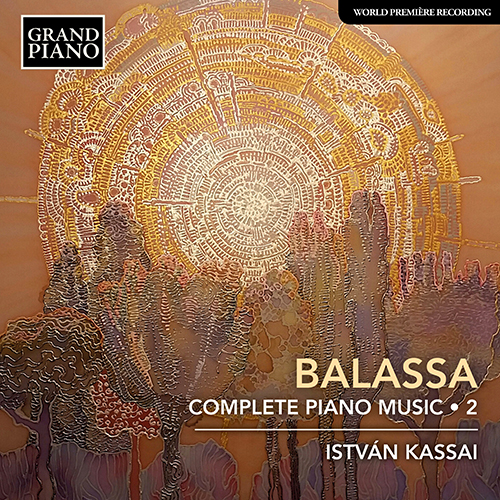
About this Release
“For the second album in my survey of Sándor Balassa's complete works for piano, the programme focuses on his sonatinas. The composer describes the primary quality of the works on this particular album as balancing "between form and the diversity of instrumental characteristics." The Sonatina for Harp, the Four Performance Pieces for Cimbalom and Artist Lane 11/a, written for modern harpsichord, are not only effective when played on the original instruments, but have also proven to be excellent performance pieces on the piano as well. The recording is framed by two virtuosic concert pieces, and has resulted in a delightful programme.” — István Kassai
BALASSA, SÁNDOR (1935–2021)
Complete Piano Music • 2
- István Kassai, piano
Sándor Balassa’s distinguished reputation in his native Hungary and beyond rests in numerous operas and orchestral works. But here, the sheer diversity of his piano music equally provides ‘a feeling of richness, inspires a sense of adventure, and touches our hearts’. His sophisticated, lyrical style is heard in educational Sonatinas, adaptations of works both virtuoso and visionary originally for harp, cimbalom and harpsichord, and even include a Gallop in 3/4 time, justified by the composer as being about a three-legged horse.
This recording was made on a modern instrument: Steinway, Model D
Tracklist
|
Művész utca 11/a (Artist Lane 11/a), Op. 101 (2007) (00:12:00 )
|
|
1
No. 1. Bekopogó (Knocking on the Door) * (00:01:32)
|
|
2
No. 2. Kettős történet (A Twofold Story) * (00:02:53)
|
|
3
No. 3. Közjáték (Interlude) * (00:02:25)
|
|
4
No. 4. Toccata * (00:02:23)
|
|
5
No. 5. Búcsúzó (Farewell) * (00:02:43)
|
|
Albumlapok Sayakának (Pages from an Album for Sayaka), Op. 140 (2013) (00:09:00 )
|
|
6
No. 1. A "h" története (The Story of "B") * (00:01:18)
|
|
7
No. 2. Az utánzó (The Mimic) * (00:00:38)
|
|
8
No. 3. Itt állt a ház (The House Was Here) * (00:01:31)
|
|
9
No. 4. Pásztorok (Shepherds) * (00:00:54)
|
|
10
No. 5. Mi történt? (What Has Happened?) * (00:00:58)
|
|
11
No. 6. Ringató (Gently Rocking) * (00:00:54)
|
|
12
No. 7. Jóbarát (Good Friend) * (00:01:21)
|
|
13
No. 8. Szeszélyes (Capricious) * (00:01:08)
|
|
Bagatellek és szekvenciák (Bagatelles and Sequences), Op. 17 (c1970) (00:05:00 )
|
|
14
Bagatelle No. 1: Vivace * (00:00:31)
|
|
15
Bagatelle No. 2: Andante * (00:01:05)
|
|
16
Bagatelle No. 3: Andante rubato * (00:00:58)
|
|
17
Bagatelle No. 4: Allegro * (00:00:30)
|
|
18
Sequence No. 1: Allegro giusto * (00:00:26)
|
|
19
Sequence No. 2: Lento * (00:01:10)
|
|
3 Szonatina zongorára A.B.C. (3 Piano Sonatinas A.B.C.), Op. 131 (2009) (00:09:00 )
|
|
20
Sonatina A: I. Allegretto grazioso * (00:00:45)
|
|
21
Sonatina A: II. Andante cantabile * (00:00:52)
|
|
22
Sonatina A: III. Allegro moderato * (00:00:53)
|
|
23
Sonatina B: I. quarter note = 66 * (00:01:06)
|
|
24
Sonatina B: II. Vivace * (00:01:08)
|
|
25
Sonatina C: I. Tranquillo * (00:01:31)
|
|
26
Sonatina C: II. Allegro * (00:01:13)
|
|
27
Sonatina C: III. Andante cantabile * (00:01:07)
|
|
Piano Sonatina No. 1, Op. 136 (2014) (00:05:00 )
|
|
28
I. half note = 56 * (00:01:58)
|
|
29
II. Allegretto * (00:01:06)
|
|
30
III. quarter note = 104 * (00:01:32)
|
|
Harp Sonatina, Op. 47 () (00:05:00 )
|
|
31
I. Allegretto * (00:01:57)
|
|
32
II. Andante * (00:01:37)
|
|
33
III. Allegro giusto * (00:01:36)
|
|
4 Concert Pieces for Cimbalom, Op. 98 (2006) (00:07:00 )
|
|
34
No. 1. Kétszólamú gyakorlat (2-Voice Study) * (00:01:15)
|
|
35
No. 2. Szeszélyes játék (Skittish Game) * (00:01:56)
|
|
36
No. 3. Rubato és Giusto (Rubato and Giusto) * (00:01:51)
|
|
37
No. 4. Kis rondo (Little Rondo) * (00:02:16)
|
|
Piano Sonatina No. 2, Op. 83 (2006) (00:14:00 )
|
|
38
I. Allegretto * (00:02:04)
|
|
39
II. Allegro scherzando * (00:02:46)
|
|
40
III. Adagio * (00:04:01)
|
|
41
IV. Allegro molto * (00:04:52)
|
The Artist(s)
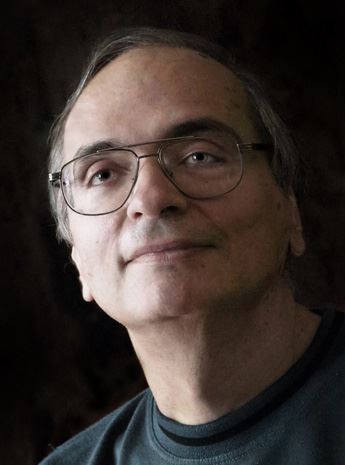 Kassai has won several first prizes in international competitions such as the International Piano Competition for Young Artists in 1972 in Czechoslovakia, the Piano Competition organised by Hungarian Radio in 1979, and the Paris International Debussy Piano Competition in 1982. Moreover, Kassai’s artistic talent was acknowledged by such prestigious awards as the ARTISJUS-Prize in 1976, the Bonnaud-Chevillion-Prize of the Fondation de France in 1986, the Nívó Prize of Hungarian Radio in 1990, the Ferenc Liszt Prize in 2001 and the Leó Weiner Memorial Prize in 2010. He has been a full member of the Hungarian Academy of Art since 2013.
Kassai has won several first prizes in international competitions such as the International Piano Competition for Young Artists in 1972 in Czechoslovakia, the Piano Competition organised by Hungarian Radio in 1979, and the Paris International Debussy Piano Competition in 1982. Moreover, Kassai’s artistic talent was acknowledged by such prestigious awards as the ARTISJUS-Prize in 1976, the Bonnaud-Chevillion-Prize of the Fondation de France in 1986, the Nívó Prize of Hungarian Radio in 1990, the Ferenc Liszt Prize in 2001 and the Leó Weiner Memorial Prize in 2010. He has been a full member of the Hungarian Academy of Art since 2013. 

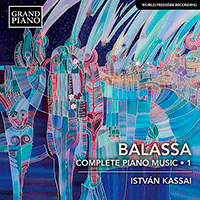
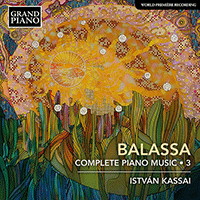
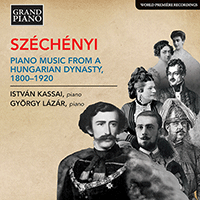
 Grand Piano has gained a reputation for producing high quality recordings of rare keyboard gems. Dedicated to the exploration of undiscovered piano repertoire, the label specialises in complete cycles of piano works by many lesser-known composers, whose output might otherwise have remained unknown and unrecorded.
Grand Piano has gained a reputation for producing high quality recordings of rare keyboard gems. Dedicated to the exploration of undiscovered piano repertoire, the label specialises in complete cycles of piano works by many lesser-known composers, whose output might otherwise have remained unknown and unrecorded.






